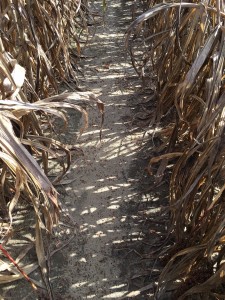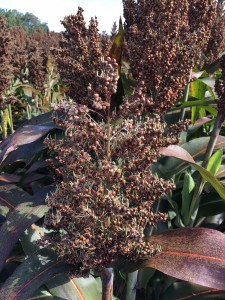Ample amounts of rainfall, humidity and the warm weather recently experienced by southeastern Virginia resulted in grain sorghum sprouting
and shattering. This was observed in Suffolk, Isle of Weight, and Eastern Shore, with variable severity due to the weather conditions specific to each location and field.
Sorghum has small seeds and does not take much water to germinate. If the weather is right, prolonged moisture, humidity, and high temperatures, it may sprout before harvest. Radicle and coleoptile will extrude from the kernels still attached to the head while feeding on the endosperm starch reserve for growth. Because of this, kernels will become lighter (test weight will be substantially reduced), trashier and, in some instances, discolored. After rainfall stops, radicles and coleoptiles will eventually dry and die. Weathered sorghum nutritional value for feedstock and poultry uses is not significantly altered; but kernels become more prone to mold infection and mycotoxin contamination after sprouting.
Maturity and desiccation play significant roles in the severity of sprouting. For example, late planted sorghum after wheat may not sprout because the germs are not yet fully developed. Among the early planted sorghums, the early maturing hybrids are less prone to pre-harvest sprouting because their seed moisture is low compared with late maturing hybrids and requires more water to imbibe. None the less, our tests this year clearly show that timely desiccation in preparation for harvest (when seeds have around 25% moisture) significantly reduced kernel sprouting.
At this time, I do not know how much price will be reduced, or what quality markers will be used to evaluate quality when delivering sprouted sorghum to Murphy Brown. I attach here Waverly-Milo-Discount the discount schedule at the Waverley Mill and I will keep you informed on this topic.


